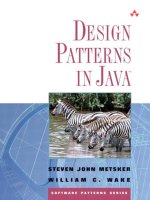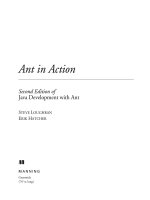Cisco press cisco router configuration 2nd edition dec 2000 ISBN 1578702410
Bạn đang xem bản rút gọn của tài liệu. Xem và tải ngay bản đầy đủ của tài liệu tại đây (3.53 MB, 497 trang )
•
•
TableofContents
Index
CiscoRouterConfiguration,Second
Edition
ByAllanLeinwand,BrucePinskyCCIE
#1045
Publisher :CiscoPress
PubDate :December20,2000
ISBN :1-57870-241-0
Pages :360
Slots :1
Theobjectiveofthisbookistohelpyou,the
noviceCiscousers,withthebasic
administrationofyourinternetworking
devices.Usingstraightforwardcasestudies
andpracticalexamples,CiscoRouter
Configuration,2EteachesIOSfundamentals
forconfiguring,operating,andmaintaining
internetworkingdevices.CiscoRouter
Configuration,2Eprovidesanoverviewof
CiscoIOSsoftware.Itdescribesbasic
informationonCiscodevicesanddevice
interfaces(Ethernet,TokenRing,FDDI,
FrameRelay,ATM).ThebasicsofIP,IPX,and
AppleTalkareexplained,andthebookshows
howtouseCiscoIOSsoftwaretoconfigure
addresses,routes,androutingprotocols
withinthesethreeprotocols.Finally,Cisco
RouterConfiguration,2Eprovidesan
elaborateexampleofanentirenetworksetup
withcompleteCiscoIOSconfigurations.All
informationinthesecondeditionwillinclude
CiscoIOS12.0syntax.
•
•
TableofContents
Index
CiscoRouterConfiguration,Second
Edition
ByAllanLeinwand,BrucePinskyCCIE
#1045
Publisher :CiscoPress
PubDate :December20,2000
ISBN :1-57870-241-0
Pages :360
Slots :1
Copyright
AbouttheAuthors
AbouttheTechnicalReviewers
Acknowledgments
Introduction
Objectives
Audience
Organization
ABriefHistoryofCiscoSystems
BookFeaturesandElements
Chapter1.GettingStartedinInternetworking
TheOSIReferenceModel
TypesofInternetworkingDevices
AnInternetworkExample
References
Summary
Chapter2.TheBasicsofDeviceConfiguration
PreliminaryConfigurationSteps
References
Chapter3.TheBasicsofDeviceInterfaces
BasicInterfaceConfiguration
Local-AreaNetworkTechnologies
Wide-AreaNetworkandDialupNetworkTechnologies
References
Summary
Chapter4.TCP/IPBasics
TCP/IPAddressing
ConfiguringIPAddresses
IPRoutingConfiguration
ViewingDynamicRoutingProtocolInformation
ConfiguringBasicIPDialupServices
ConfiguringOtherIPOptions
References
ConfiguringIPRoutingProtocols
ConfiguringIPFilteringviaAccessLists
VerifyingIPConnectivityandTroubleshooting
Summary
Chapter5.AppleTalkBasics
AppleTalkAddressingandAddressStructure
ConfiguringAppleTalkAddresses
AppleTalkRoutingConfiguration
ConfiguringAppleTalkFilteringviaAccessLists
ConfiguringBasicAppleTalkDialupServices
Summary
ConfiguringAppleTalkRoutingProtocols
VerifyingAppleTalkConnectivityandTroubleshooting
References
Chapter6.IPXBasics
IPXAddressingandAddressStructure
ConfiguringIPXAddresses
IPXRoutingConfiguration
ConfiguringStaticRouting
ConfiguringIPXRoutingProtocols
ConfiguringIPXRoutingCommands
VerifyingIPXRoutingConfiguration
SAP
SAPFilters
ConfiguringNLSP
ConfiguringIPXFilteringviaAccessLists
VerifyingIPXConnectivityandTroubleshooting
Summary
ConfiguringIPXRIP
ConfiguringIPXEIGRP
ConfiguringBasicIPXDialupServices
ConfiguringIPXType20PacketForwarding
References
Chapter7.BasicAdministrativeandManagementIssues
BasicAccessControl
BasicAttackPrevention
BasicLogging
BasicTimeControl
References
BasicNetworkManagement
Summary
Chapter8.ComprehensiveIOSConfigurationfortheZIPNetwork
TheKuala-LumpurRouter
TheSF-1Router
TheSF-2Router
TheSF-Core-2Router
TheSeoul-1Router
TheSeoul-2Router
TheSingISDNAccessServer
Summary
TheSF-Core-1Router
TheSan-JoseRouter
TheSingaporeRouter
TheSing2511AccessServer
Index
Copyright
Copyright©2001CiscoPress
CiscoPresslogoisatrademarkofCiscoSystems,Inc.
Allrightsreserved.Nopartofthisbookmaybereproducedortransmittedinanyformor
byanymeans,electronicormechanical,includingphotocopying,recording,orbyany
informationstorageandretrievalsystem,withoutwrittenpermissionfromthepublisher,
exceptfortheinclusionofbriefquotationsinareview.
LibraryofCongressCataloging-in-PublicationNumber:00-109754
PrintedintheUnitedStatesofAmerica
FirstPrintingDecember2000
123456789004030201
TrademarkAcknowledgments
Alltermsmentionedinthisbookthatareknowntobetrademarksorservicemarkshave
beenappropriatelycapitalized.CiscoPressorCiscoSystems,Inc.,cannotattesttothe
accuracyofthisinformation.Useofaterminthisbookshouldnotberegardedasaffecting
thevalidityofanytrademarkorservicemark.
WarningandDisclaimer
ThisbookisdesignedtoprovideinformationaboutCiscorouterconfiguration.Everyeffort
hasbeenmadetomakethisbookascompleteandasaccurateaspossible,butno
warrantyorfitnessisimplied.
Theinformationisprovidedonan"asis"basis.Theauthor,CiscoPress,andCisco
Systems,Inc.,shallhaveneitherliabilitynorresponsibilitytoanypersonorentitywith
respecttoanylossordamagesarisingfromtheinformationcontainedinthisbookorfrom
theuseofthediscsorprogramsthatmayaccompanyit.
Theopinionsexpressedinthisbookbelongtotheauthorandarenotnecessarilythoseof
CiscoSystems,Inc.
FeedbackInformation
AtCiscoPress,ourgoalistocreatein-depthtechnicalbooksofthehighestqualityand
value.Eachbookiscraftedwithcareandprecision,undergoingrigorousdevelopmentthat
involvestheuniqueexpertiseofmembersfromtheprofessionaltechnicalcommunity.
Readers'feedbackisanaturalcontinuationofthisprocess.Ifyouhaveanycomments
regardinghowwecouldimprovethequalityofthisbookorotherwisealterittobettersuit
yourneeds,youcancontactusthroughe-mailatPleasemakesure
toincludethebooktitleandISBNinyourmessage.
Wegreatlyappreciateyourassistance.
Credits
Publisher
JohnWait
Editor-in-Chief
JohnKane
CiscoSystemsProgramManager
BobAnstey
ManagingEditor
PatrickKanouse
AcquisitionsEditor
TracyHughes
SeniorEditor
JenniferChisholm
CopyEditor
KristaHansing
TechnicalEditors
HenryBenjamin
KevinBurgess
Andre'Paree-Huff
DaveSumter
MichaelTruett
CoverDesigner
LouisaKlucznick
Compositor
SteveGifford
Indexer
TimWright
Proofreaders
ChrissyAndry
GayleJohnson
Dedications
AllanLeinwandwouldliketodedicatethisbooktohisfamilyandfriends,whohave
providedcontinualsupport,suggestions,encouragement,andinsightsthroughoutthe
writingofthisbook.
BrucePinskywouldliketothankallhisfriendsandfamily,whohaveprovidedtheir
supportinhelpingtomakethisbookareality.Anextraspecialthankyougoestohiswife,
Paula,andsons,EricandKyle,fortheirtirelesssupportduringthemanynightsand
weekendsdedicatedtothecompletionofthistext.
AbouttheAuthors
AllanLeinwandistheChiefTechnologyOfficerandVicePresidentofEngineeringat
TelegisNetworks,Inc.Previously,asChiefTechnologyOfficerandVicePresidentof
EngineeringforDigitalIsland,Inc.,hewasresponsibleforthetechnicaldirectionofthe
company'sglobalnetworkandcontentdistributionstrategy.BeforeDigitalIsland,hewasa
ConsultingEngineeringManageratCiscoSystems,Inc.,responsiblefortheglobalnetwork
designofcustomernetworks.AllanreceivedhisBSinComputerScienceattheUniversity
ofColoradoatBoulderin1988,andhasbeenworkingininternetworkingtechnologyand
solutionsforlargecorporationssincethattime.Heteachesgraduatecomputernetworking
coursesfortheUniversityofCalifornia,Berkeley;haspublishedmanypapersonnetwork
managementandnetworkdesign;andistheco-authoroftheAddison-Wesleytext
NetworkManagement:APracticalPerspective,SecondEdition.
BrucePinsky,CCIE#1045,istheVicePresidentofProductEngineeringandNetwork
InfrastructureatTelegisNetworks,Inc.Previously,asChiefInformationOfficer,Vice
PresidentofSolutionsEngineering,andChiefNetworkStrategistofDigitalIsland,Inc.,he
wasresponsibleforthedirectionanddeploymentofcorporatetechnologyinfrastructure
andadvancedtechnologyresearch.BeforeDigitalIsland,BrucewasaSeniorInternetwork
SupportTechnologistatCiscoSystems,Inc.,andwasresponsiblefortheescalationof
complexcustomertechnicalissues.HereceivedhisBSinComputerScienceatCalifornia
StateUniversity,Hayward,in1988,andhehasbeenworkingininternetworking
technologyandsystemsintegrationforlargecorporationsandconsultingfirmsbeforeand
sincethattime.OneoftheoriginalCiscoCertifiedInternetworkEngineers,Brucehas
expertiseinsuchtopicsasnetworktroubleshootingandprotocolanalysis,networkdesign
andconfiguration,andworkstationandserver-basedoperatingsystems.Heroutinely
teachescoursesonnetworkconfiguration,design,andtroubleshooting,andisco-inventor
ofpatentedroutingtechnology.
AbouttheTechnicalReviewers
HenryBenjamin,CCIE,CCNA,CCDA,B.Eng.,isaCiscoCertifiedInternetworkExpert
andanITnetworkengineerforCiscoSystems,Inc.Hehasmorethan10yearsof
experienceinCisconetworks,includingplanning,designing,andimplementinglargeIP
networksrunningIGRP,EIGRP,andOSPF.Inthepastyear,Henryhasfocusedon
architecturaldesignandimplementationinCiscointernalnetworksacrossAustraliaand
theAsia/Pacificregion.HeistheauthorofabookdedicatedtopassingtheCCIEwritten
examandhashelpedwithmanyothertitlesrelatedtoCiscoIOS.HenryholdsaBachelor
ofEngineeringDegreefromSydneyUniversity.Thisreviewisdedicatedtohissickmum.
KevinBurgesshasbeendoingnetworkdesign,analysis,andmaintenanceforthepast10
years.AsaNetworkEngineerwithEDSforthepastfiveyears,hehasworkedonvarious
projectsacrossCanada.KevinholdscertificationsfromNovellandCiscoandiscurrently
workingonhisCCIE.
AndréParee-Huff,CCNP,MCSE+I,ASE,A+,Network+,I-Network+,hasbeenworkingin
thecomputerfieldformorethan8years.HeiscurrentlyworkingforCompaqComputer
CorporationasaNetworkSupportEngineer,LevelIII,fortheNorthAmericaCustomer
SupportCenterinColoradoSprings,Colorado.Andréhandlestroubleshootingofnetwork
hardware,specializinginLayers2and3oftheOSImodel.Andréhasco-authoredfour
network-relatedtechnicalmanualsandhasbeenatechnicaleditoronmanyothers.Heis
currentlyworkingtowardhisCCIE.
DaveSumter,CCIE#4942,CCDP,hasbeeninthenetworkingindustryforclosetofive
yearsandhasbeenconcentratingsolelyonCiscosolutionsforthelastthreeyearsHe
worksforCiscoSystems,Inc.,inSouthAfrica.Dave'scurrentdutiesinvolvethedesignof
large-scalecampusandWANsolutionsforcorporateandgovernmentclientsinSouth
Africa.OtherdutiesinvolvetheongoingtrainingofCiscopartnersandparticipationinthe
examinationofCCIEcandidatesattheCCIEroutingandswitchinglabinSouthAfrica.
MichaelTruett,CCNP,isanetworkengineerforalargeorganizationspecializinginVoIP.
HeiscurrentlyworkingonhisCCDPandCCIE.Hisstrengthliesintheareaofnetwork
design,implementation,andtroubleshootingforlargenetworksonmanydifferentmedia
types,includingFrameRelayandsatellite.Inhissparetime,Michaelalsoteachesseveral
classesonCiscoroutersandswitches.
Acknowledgments
WewouldliketosaythankyoutothediligentandpersistenteffortsofTracyHughes,the
entireCiscoPressstaff,andourtechnicalreviewersinhelpingtocompletethisbook.
Introduction
CiscoSystems,Inc.,istheleadingglobalsupplierofinternetworkinghardwareand
software,withmorethan100,000devicesdeployedthroughoutpublicandprivate
internetworkseachyear.Atthetimeofthiswriting,thesedevicescarrymorethan80
percentofthepublicInternet'straffic.TheaimofthisbookistohelpnoviceCiscousers
withthebasicadministrationoftheirinternetworkingdevices.
EachofthesedeviceshasCiscoproprietaryoperatingsystemsoftwarecalledtheCisco
InternetworkOperatingSystem(IOS).TheCiscoIOSsoftwareisacomplicatedreal-time
operatingsystemconsistingofmultiplesubsystemsandtensofthousandsofpossible
configurationparameters.Usingstraightforward,chronologicaldescriptionsandpractical
examples,thisbookfocusesontheCiscoIOSsoftwarewithrespecttoconfiguring,
operating,andmaintaininginternetworkingdevices.Inadditiontocoveringgeneral
aspectsoftheIOS,weconsideritinthecontextofthethreemostpopularnetworking
protocolsusedtoday:theTransmissionControlProtocol/InternetProtocol(TCP/IP),Novell
Inc.'sInternetworkPacketExchange(IPX),andAppleComputerInc.'sAppleTalk.
Objectives
ThecentralobjectiveofthisbookistomaketheCiscoIOSsoftwareeasytoconfigure,
operate,andmaintainfornoviceusers.TheIOSdocumentationthatcomeswitheach
CiscoproductcoversmultipleCD-ROMsandoffersacomprehensivelookateach
command,withalltherelevantoptions.Thedocumentationoftenintimidatesandconfuses
peoplewhentheyaretryingtoconfigureaCiscoproductforabasicinternetwork.
Thisbookisintendedtoserveasasupportive,morefocusedpartnertotheavailable
documentationbycoveringthecommonlyusedIOScommandsandthemostpopular
options.Throughtheuseofcopiousexamples,illustrations,andCiscoIOSsoftware
configurationoutput,weexplaintheuseoftheIOSforavarietyofusersand
internetworkingconfigurations.Anexampleinternetworkforafictitiouscompany,Zoom
IntegratedProducts(ZIP),isacontextthroughoutthebooktohelpillustrateconcepts.As
weintroduceconfigurationcommandsandstrategies,wealsoimplementthemforthe
specificdevicesandtopologyoftheZIPnetwork.
Audience
ThisbookisintendedforanybeginninguseroftheCiscoIOSsoftware.Advancedusers
willalsofindthisreferencevaluablebecauseofthemanyexamplesandtipsforusing
commonIOSfeatures.
Weassumethatthereaderhassomegeneralbackgroundinthevarioustypesof
internetworkingequipment,suchashubs,bridges,switches,androuters.Coverageofthe
intricatedetailsofthesetypesofequipmentisoutsidethescopeofthisbook,butwe
reviewthembrieflywithrespecttotheCiscoIOSsoftware.Likewise,comprehensive
introductionstoTCP/IP,AppleTalk,andIPXarelefttotheseveralfinetextsalready
available,someofwhicharereferencedattheendofeachchapter.Insteadofduplicating
existingreferencesonspecificinternetworkingequipmentandprotocols,thisbook
concentratesontheuseofthesetechnologiesbyproductsthatruntheCiscoIOSsoftware.
Organization
Chapter1,"GettingStartedinInternetworking,"reviewstheOSIreferencemodeland
givesanoverviewofthegeneraltypesofinternetworkingdevicesthatareatissueinthis
book:bridges,switches,androuters.Thechapterconcludesbydescribingacomplete
exampleinternetworkforthefictionalZoomIntegratedProducts(ZIP)company.
Chapter2,"TheBasicsofDeviceConfiguration,"describesthebasicinformationthatyou
needtoknowaboutaCiscodevice,startingwithitsconfigurationoutofthebox.Topics
coveredincludehowtoaccesstheconsoleport,basicterminalconfiguration,CiscoIOS
softwaresetupmode,context-sensitivehelp,privilegedmode,andtheIOSconfiguration
commandstructure.Thischapteralsoexplainssomeofthephysicalcharacteristicsofa
Ciscodevice,suchasaccessingrandomaccessmemory(RAM),savingconfiguration
informationtononvolatileRAM(NVRAM),andtransferringCiscoIOSsoftwareimagesto
Flashmemory.
Chapter3,"TheBasicsofDeviceInterfaces,"explainswhatyouneedtoknowaboutthe
variousnetworkinterfacetypesfoundonaCiscodevice.Thechapterintroduceseachof
thefollowinginterfacetypesandgivesexamplesofhowtoconfiguretheCiscoIOS
softwareforeach:Ethernet,FastEthernet,GigabitEthernet,TokenRing,FiberDistributed
DataInterface(FDDI),High-LevelDataLinkControl(HDLC),Point-to-PointProtocol(PPP),
X.25,FrameRelay,AsynchronousTransferMode(ATM),DigitalSubscriberLoop(DSL),and
IntegratedServicesDigitalNetwork(ISDN).Thechapterincludesexplanationsofhowto
useCiscoIOSsoftwarecommandstoexamineinterfacestatusandhealth.
Chapter4,"TCP/IPBasics,"explainsthebasicsoftheInternetProtocol(IP):subnetting
androuting.ThechapteralsoshowsyouhowtousetheCiscoIOSsoftwaretoconfigureIP
addresses,IProutes,IProutingprotocols(RIP,IGRP,OSPF,EIGRP,andBGP4),IPnetwork
security,anddialupIP.OtherIPnuancesintheCiscoIOSsoftware,suchasDomainName
Service(DNS)configuration,IPbroadcastforwarding,DHCPservices,andredundancy,are
alsoexplained.
Chapter5,"AppleTalkBasics,"coversavarietyoftopics,startingwithanoverviewofthe
AppleTalkprotocolsuite.ThechapterthencoverstheIOSconfigurationofAppleTalkcableranges,zones,routingprotocols(RTMPandEIGRP),AppleTalknetworksecurity,anddialup
AppleTalk.
Chapter6,"IPXBasics,"firstoverviewsthecomponentsoftheNovellInternetworkPacket
Exchange(IPX)protocol:networknumbers,theServiceAdvertisingProtocol(SAP),and
routing.NextiscoverageofusingtheIOStoconfigureIPXaddresses,multipleLAN
encapsulationmethods,routes,routingprotocols(RIP,NLSP,andEIGRP),IPXnetwork
security,anddialupIPX.
Chapter7,"BasicAdministrativeandManagementIssues,"explainsotherbasic
configurationitemsintheIOSthatyouneedtounderstand.Theseitemsincludeaccess
control,usingSecureShell(SSH)toaccessanIOSdevice,loggingmessages,network
managementprotocols,andclock/calendarcontrol.Thechaptershowshowtoconfigure
theSimpleNetworkManagementProtocol,theTerminalAccessControllerAccessControl
System(TACACSandTACACS+),theRemoteAuthenticationDial-InUserService
(RADIUS),andtheNetworkTimeProtocol(NTP).
Chapter8,"ComprehensiveIOSConfigurationfortheZIPNetwork,"givescompleteIOS
configurationsfortheentireexampleZIPnetwork.Thischaptersummarizesthe
configurationexamplesseenthroughoutthetext.
BookFeaturesandElements
Thisbookutilizesanumberofelementsandconventionstohelppresentinformationas
clearlyaspossibleandtoreiteratekeyconcepts.Oneconventionalreadynotedisthe
practiceofusingasingleexamplenetworkthroughoutthebookasacontextfor
configurationsamples.YoucanfindanillustrationoftheZIPnetworkontheinsidefront
coverforconvenientreference.
Naturally,configurationcodeformsacentralelementofthisbook.Codefragmentsare
presentedinadistinctivetypeface(monotype)foreasyidentification.Inputthatmustbe
typedbytheuserisdistinguishedbyboldincodefragments.Individualcodetermsthat
appearinparagraphsarepresentedinbold.
Otherelementsusedinthistextareasfollows:
NotesSidebarcommentsthatarerelatedtothediscussionathandbutthatcanbe
skippedwithoutlossofunderstandingorcontinuity.
TipsSidebarcommentsthatdescribeanefficiency,shortcut,oroptimalwayofusing
thetechnology.
FurtherReferenceSidebarpassagesthatidentifysourcesoffurtherinformationon
texttopics.
SummarytablesofcommandsReferenceandreiterationofthemostimportant
newcommandsandsyntaxintroduced;theseappearattheendsofrelevant
chapters.
ABriefHistoryofCiscoSystems
CiscoSystemsoriginatedwithLenandSandyBosack,ahusbandandwifeworkingin
differentdepartmentsatStanfordUniversity.Theyneededtoenabletheircomputer
systemstocommunicatewithoneanother.Indevelopingasolutionforthisproblem,they
builtadevicecalledagatewayserver.Thegatewayserverhelpedthemachinesinthetwo
departmentsatStanfordUniversitycommunicatethroughtheuseoftheInternetProtocol
(IP).Thatwasinthemid-1980s.
Notlongafterthisachievement,LenandSandydecidedtotakeachanceandattemptto
produceacommercialgatewayserverproduct.Thefirstdevelopmentandproduction
facilityforCiscowastheBosacks'livingroom.In1984,ciscoSystems,Inc.,wasfounded,
andaneweraininternetworkingwasformed.
Notethelowercasecinthecompany'soriginalname;therearemanyrumorsand
explanationregardingit.Ithasbeeninterpretedasanattempttoconfuseeditorswhen
theyarebeginningasentencewiththecompanyname;amistakemadebylawyers
draftingthecompanyname;arippedpieceofpaperthatoriginallysaidSanFrancisco
Systems,Inc.;andjustanameintendedtobeunique.Wedonotsharethetruthhere
becauseweprefertokeepthemysteryalivechoosetheanswerthatyouprefer.In1992,
thecompanynamewaschangedofficiallytoCiscoSystems,Inc.ThemovetothecapitalC
wasmetwithsomehesitancybytheciscofaithful,buttodaythenameCiscoSystems,
Inc.,isusedbymost,exceptperhapsthedie-hardengineersfromthedaysofcisco
Systems.
ThefirstgatewayproductfromCiscowastheAdvancedGatewayServer(AGS),followed
soonbytheMid-RangeGatewayServer(MGS),theCompactGatewayServer(CGS),the
IntegratedGatewayServer(IGS),andtheAdvancedGatewayServerPlus(AGS+).These
productsarenowknownastheoldalphabetsoupproductsfromthecompany.Thenext
generationofproductsbegantoemergein1993withtheCisco4000seriesrouters,which
wassoonfollowedbytheCisco7000,2000,and3000routerseries.ThefamilyofCisco
productscontinuestoevolvetoday,followingthisconventionofusingproductnumbers
ratherthannames,withproductssuchastheCisco12000routersandCatalyst6500
switches.
Inthemid-1990s,Ciscobegantodiversifyitsproductlinefromrouterstoother
internetworkingproducts,suchasLANswitches,ATMswitches,WANnetworkingproducts,
IBMconnectivity,andmore.
WithallthediversificationofCiscoproducts,theinherentcomplexityoftheCiscoIOS
software,andthewidespreadgrowthofinternetworkimplementation,networkdesigners
andmanagerscanfeeloverwhelmedbytheamountofinformationthattheyneedtosift
throughtoevenbeginconfiguringanetworkwithCiscodevices.Atitscore,thisbookhas
theobjectiveofdistillingtheessentialsneededtoconfiguretheCiscoIOSsoftwarefrom
thevastamountofavailableinformationanddocumentation.Ourgoalinwritingthisbook
wastomaketheimpressiveproductsofCisco,whichfromtheirbeginninghavebeen
solvinginternetworkingproblems,asaccessibletonovicesastheyaretotheveteranusers
oftheIOS.
Chapter1.GettingStartedinInternetworking
TheOSIReferenceModelReviewofthesevenlayersoftasksthatmake
communicationssystemsoperate.
TypesofInternetworkingDevicesThemaindevicesonaninternetwork:bridges,
switches,routers,andaccessservers.
AnInternetworkExampleAspecificinternetworktopologythatisusedasanexample
throughoutthebook.
Thischapterhelpsyoustartlearningaboutinternetworking.Understandingthiscomplex
topicisthefirststeptowardunderstandingtheCiscoInternetworkOperatingSystem
(IOS).TheIOSprovidestheintelligencethatCiscoproductsrequiretoperformtheir
variousinternetworkingtasks.TheIOSisanoperatingsystemwithaproprietaryuser
interface,commandset,configurationsyntax,andsoon.TheIOSistoCiscodevicesas
Windows2000istoIBM-compatiblepersonalcomputers.TheIOSrunsonalltheCisco
productsdiscussedinthistext.
Weencourageyoutohaveafirmgraspoftheinternetworkingprinciplessurveyedinthis
chapterbeforeyouattempttounderstandthecomplexitiesoftheCisco
IOS.Internetworkingisatermusedtodescribethecollectionofprotocolsanddevicesthat
interoperateondatanetworks.Thischaptergivesyouthebasicunderstandingofthe
subject;itisnotmeanttogiveyoucomprehensivecoverageofthesubject(whichcould
takemultiplebookstocovercompletely).Ifyouneedamoreextensiveintroductionto
internetworking,afewgoodtextsarecitedinthe"References"sectionattheendofthis
chapter.
Whenyoufinishthischapter,youshouldbecomfortablewiththeOSInetworkingmodel
andhaveabasicunderstandingofhowbridges,switches,routers,andaccessservers
work.Chapter2,"TheBasicsofDeviceConfiguration,"introducesyoutothebasicsof
configuringaCiscodevice.
TheOSIReferenceModel
TheOpenSystemInterconnection(OSI)referencemodelisaprincipleofinternetworking
thatyoumustunderstandtoappreciatethewayCiscodevicesoperate.TheOSIreference
modelisaseven-layerarchitecturalmodeldevelopedbytheInternationalOrganizationfor
Standardization(ISO)andtheInternationalTelecommunicationsUnionTelecommunications(ITU-T).Itisuseduniversallytohelpindividualsunderstandnetwork
functionality.TheOSIreferencemodeladdsstructuretothemanycomplexitiesinvolvedin
thedevelopmentofcommunicationssoftware.Thedevelopmentofcommunications
softwareinvolvesmanytasks,includingdealingwithmultipletypesofapplications,
transmissionstrategies,andphysicalnetworkproperties.Withoutstructure,
communicationssoftwaremightbedifficulttowrite,change,andsupport.
Note
ISOisaninternationalorganizationfoundedtopromotecooperationintechnological
developments,particularlyinthefieldofcommunications.ITU-T,ontheotherhand,isa
globalorganizationthatdraftsstandardsforallareasofinternationalanaloganddigital
communications.ITU-Tdealswithtelecommunicationsstandards.
TheOSIreferencemodelisdividedintosevendistinctlayers.Eachlayerperformsa
specific,distincttaskthathelpscommunicationssystemsoperate.Thelayeroperates
accordingtoasetofrules,whichiscalledaprotocol.Inadditiontofollowingtherulesof
theprotocol,eachlayerprovidesasetofservicestotheotherlayersinthemodel.The
sevenlayersoftheOSIreferencemodelaretheapplication,presentation,session,
transport,network,datalink,andphysicallayers,asshowninFigure1-1.Inthefollowing
sections,webrieflyrevieweachlayer,startingwiththeapplicationlayer.
Figure1-1.TheOSIReferenceModelContainsSevenLayers
TheApplicationLayer
Theapplicationlayerprovidestheinterfacetothecommunicationssystem,whichtheuser
sees.Manycommonapplicationsareusedtodayinaninternetworkenvironment,suchas
webbrowsers,FileTransferProtocol(FTP)clients,andelectronicmail.Anexampleof
applicationlayercommunicationisawebbrowserdownloadingadocumentfromaweb
server.Thewebbrowserandserverarepeerapplicationsontheapplicationlayerthat
communicatedirectlywitheachotherfortheretrievalofthedocument.Theyareunaware
ofthesixlowerlayersoftheOSIreferencemodel,whichareworkingtoproducethe
necessarycommunications.
ThePresentationLayer
Thepresentationlayerdealswiththesyntaxofdataasitisbeingtransferredbetweentwo
communicatingapplications.Thepresentationlayerprovidesamechanismtoconveythe
desiredpresentationofdatabetweenapplications.Manypeopleinferthatthelookandfeel
oftheenvironmentofacomputerdesktop,suchasthewayalltheapplicationslookand
interactuniformlyonacomputerbyAppleComputer,Inc.,isanexampleofapresentation
layer.Infact,thisisnotapresentationlayer,butaseriesofapplicationsusingacommon
programmer'sinterface.OnecommonpresentationlayerinusetodayisAbstractSyntax
NotationOne(ASN.1),whichisusedbyprotocolssuchastheSimpleNetwork
ManagementProtocol(SNMP)torepresentthestructureofobjectsinnetwork
managementdatabases.
TheSessionLayer
Thesessionlayerallowstwoapplicationstosynchronizetheircommunicationsand
exchangedata.Thislayerbreaksthecommunicationbetweentwosystemsintodialogue
unitsandprovidesmajorandminorsynchronizationpointsduringthatcommunication.For
example,alargedistributeddatabasetransactionbetweenmultiplesystemsmightuse
sessionlayerprotocolstoensurethatthetransactionisprogressingatthesamerateon
eachsystem.
TheTransportLayer
Thetransportlayer,Layer4,isresponsibleforthetransferofdatabetweentwosession
layerentities.Multipleclassesoftransportlayerprotocolsexist,fromthosethatprovide
basictransfermechanisms(suchasunreliableservices)tothosethatensurethatthe
sequenceofdataarrivingatthedestinationisintheproperorder,thatmultiplexmultiple
streamsofdata,thatprovideaflowcontrolmechanism,andthatensurereliability.
Asyouwillseeinthenextsection,somenetworklayerprotocols,calledconnectionless
protocols,donotguaranteethatthedataarrivesatthedestinationintheorderinwhichit
wassentbythesource.Sometransportlayershandlethisbysequencingthedataproperly
beforehandingittothesessionlayer.Multiplexingofdatameansthatthetransportlayer
cansimultaneouslyhandlemultiplestreamsofdata(whichcouldbefromdifferent
applications)betweentwosystems.Flowcontrolisamechanismthatthetransportlayer
canusetoregulatetheamountofdatasentfromthesourcetothedestination.Transport
layerprotocolsoftenaddreliabilitytoasessionbyhavingthedestinationsystemsend
acknowledgmentsbacktothesourcesystemasitreceivesdata.
Inthistext,wediscussthethreecommonlyusedtransportprotocols:theTransmission
ControlProtocol(TCP)thatisusedontheInternet,Novell'sStreamsPacketExchange
(SPX),andApple'sAppleTalkTransportProtocol(ATP).
TheNetworkLayer
Thenetworklayer,whichroutesdatafromonesystemtoanother,providesaddressingfor
useontheinternetwork.TheInternetProtocol(IP)definestheglobaladdressingforthe
Internet;NovelldefinesproprietaryaddressingfortheInternetworkPacketExchange
(IPX),itsclient/serverarchitecture;andApple'sAppleTalkusestheDatagramDelivery
Protocol(DDP)andproprietaryaddressingforcommunicatingbetweenitsmachinesonthe
networklayer.Inlaterchapters,weexplorethespecificsofeachofthesetypesofnetwork
layeraddresses.
Networklayerprotocolsroutedatafromthesourcetothedestinationandfallintooneof
twoclasses,connection-orientedorconnectionless.Connection-orientednetworklayers
routedatainamannersimilartousingatelephone.Theybegincommunicatingbyplacing
acallorestablishingaroutefromthesourcetothedestination.Theysenddatadownthe
givenroutesequentiallyandthenendthecallorclosethecommunication.Connectionless
networkprotocols,whichsenddatathathascompleteaddressinginformationineach
networklayer(OSI)packet,operatelikethepostalsystem.Eachletter,orpacket,hasa
sourceandadestinationaddress.Eachintermediatepostoffice,ornetworkdevice,reads
thisaddressingandmakesaseparatedecisiononhowtoroutethedata.Theletter,or
data,continuesfromoneintermediatedevicetoanotheruntilitreachesthedestination.
Connectionlessnetworkprotocolsdonotguaranteethatpacketsarriveatthedestination
inthesameorderinwhichtheyweresent.Transportprotocolsareresponsibleforthe
sequencingofthedataintotheproperorderforconnectionlessnetworkprotocols.
TheDataLinkLayer
Layer2,thedatalinklayer,providestheconnectionfromthephysicalnetworktothe
networklayer,therebyenablingthereliableflowofdataacrossthenetwork.Ethernet,Fast
Ethernet,TokenRing,FrameRelay,andAsynchronousTransferMode(ATM)areallLayer2
protocolsthatarecommonlyusedtoday.Asyouwillseethroughoutthistext,datalink
layeraddressingisdifferentfromnetworklayeraddressing.Datalinklayeraddressesare
uniquetoeachdatalinklogicalsegment,whilenetworklayeraddressingisused
throughouttheinternetwork.
ThePhysicalLayer
ThefirstlayeroftheOSIreferencemodelisthephysicallayer.Thephysicallayeris
concernedwiththephysical,electrical,andmechanicalinterfacesbetweentwosystems.
Thephysicallayerdefinesthepropertiesofthenetworkmedium,suchasfiber,twistedpaircopper,coaxialcopper,satellite,andsoon.Standardnetworkinterfacetypesfoundon
thephysicallayerincludeV.35,RS-232C,RJ-11,RJ-45,AUI,andBNCconnectors.
Note
ManypeopleaddaneighthlayertothetopoftheOSIreferencemodel,thepoliticallayer.
Althoughusedinjest,thetermpoliticallayerisoftenaccuratebecausealllowerlayersof
theOSIreferencemodelareencapsulatedwithinthepoliticsinvolvedintheorganizations
thatdesignadatanetwork.
TheDataExchangeProcess
Thesesevenlayersallworktogethertoprovideacommunicationssystem.The
communicationoccurswhenaprotocolononesystem,whichislocatedatagivenlayerof
themodel,communicatesdirectlywithitscorrespondinglayeronanothersystem.The
applicationlayerofasourcesystemlogicallycommunicateswiththeapplicationlayerof
thedestinationsystem.Thepresentationlayerofthesourcesystempassesdatatothe
presentationlayerofthedestinationsystem.Thiscommunicationoccursateachofthe
sevenlayersofthemodel.
Thislogicalcommunicationbetweencorrespondinglayersoftheprotocolstackdoesnot
involvemanydifferentphysicalconnectionsbetweenthetwocommunicationssystems.
Theinformationeachprotocolwantstosendisencapsulatedinthelayerofprotocol
informationbeneathit.Theencapsulationprocessproducesasetofdatacalledapacket.
Note
Dataencapsulationistheprocessinwhichtheinformationinoneprotocoliswrapped,or
contained,inthedatasectionofanotherprotocol.IntheOSIreferencemodel,eachlayer
encapsulatesthelayerimmediatelyaboveitasthedataflowsdowntheprotocolstack.
Startingatthesource,asshowninFigure1-2,theapplication-specificdatais
encapsulatedinthepresentationlayerinformation.Tothepresentationlayer,the
applicationdataisgenericdatabeingpresented.Thepresentationlayerhandsitsdatato
thesessionlayer,whichattemptstokeepthesessionsynchronized.Thesessionlayer
passesdatatothetransportlayer,whichtransportsthedatafromthesourcesystemto
thedestinationsystem.Thenetworklayeraddsroutingandaddressinginformationtothe
packetandpassesittothedatalinklayer.Thedatalinklayerprovidesframingforthe
packetandtheconnectiontothephysicallayer.
Figure1-2.DataFlowfromaSourceApplicationtoaDestination
ApplicationThroughtheSevenLayersoftheOSIReferenceModel
AtLayer1,asshowninthefigure,thephysicallayersendsthedataasbitsacrossa
medium,suchascopperorfiber.Thepacketthentraversesthedestinationnetworkfrom
Layer1toLayer7.Eachdevicealongthewayreadsonlytheinformationnecessarytoget
thedatafromthesourcetothedestination.Eachprotocolde-encapsulatesthepacketdata
andreadstheinformationsentbythecorrespondinglayeronthesourcesystem.
Asanexample,considerwhatoccurswhenyouopenaWebpageusingaWebbrowser.
GivenaURL,suchaswww.telegis.net,yourbrowseraskstheTCPtoopenareliable
connectiontotheWebserverthatislocatedathttp://www.telegis.net.(Manyapplications
thatuseTCPskipthepresentationandsessionlayers,aswedointhisexample.)TCPthen
requeststhenetworklayer(IP)torouteapacketfromthesourceIPaddresstothe
destinationIPaddress.ThedatalinklayertakesthisIPpacketandencapsulatesitagain
fortheparticulartypeofdatalinkleavingthesourcesystem,suchasEthernet.The
physicallayercarriesthesignalfromthesourcesystemtothenextsystemenroutetothe
destination,suchasarouter.
Therouterde-encapsulatesthedatalinklayer;readsthenetworklayerinformation;reencapsulatesthepacket,ifnecessary,toplaceitonthenextdatalinkenroutetothe
destination;androutesthepacketappropriately.
ThisprocesscontinuesuntilthepacketreachesthedestinationIPaddress.Atthe
destinationIPaddress,thedatalinklayerde-encapsulatesthepacket,seesthatthe
destinationIPaddressisthelocalsystem,andpassesthedataintheIPpackettothe
transportlayer.Thetransportlayerensuresthereliabilityoftheconnectionandpassesthe
datafromyourWebbrowsertothewww.telegis.netWebserver.TheWebserverthen
respondstoyourWebbrowserrequestandsendsaWebpageofdatabacktoyour
browser(usingthesameprocess,butwiththesourceanddestinationIPaddresses
reversed).
Ciscodevicescoveredinthisbookoperateatthephysical,datalink,andnetworklayersof
theOSIreferencemodelandreadinformationintheselayerstocarrydatafromone
locationtoanother.Throughoutthisbook,wereferencetheselayersandexplainhowthe
CiscoIOSusestheprotocolinformationateachlayer.SomeCiscodevices,suchasbridges
andswitches,operateatthedatalinklayer.OtherCiscodevices,suchasrouters,operate
atthenetworklayer,asshowninFigure1-3.Wedescribethevarioustypesof
internetworkingdevicesinthenextsection.
Figure1-3.AnOSIReferenceModelDepictionofDataThatTravels
fromaSourceHost,ThroughaCiscoSwitch,ThroughaCiscoRouter,
andThentoaDestinationHost









